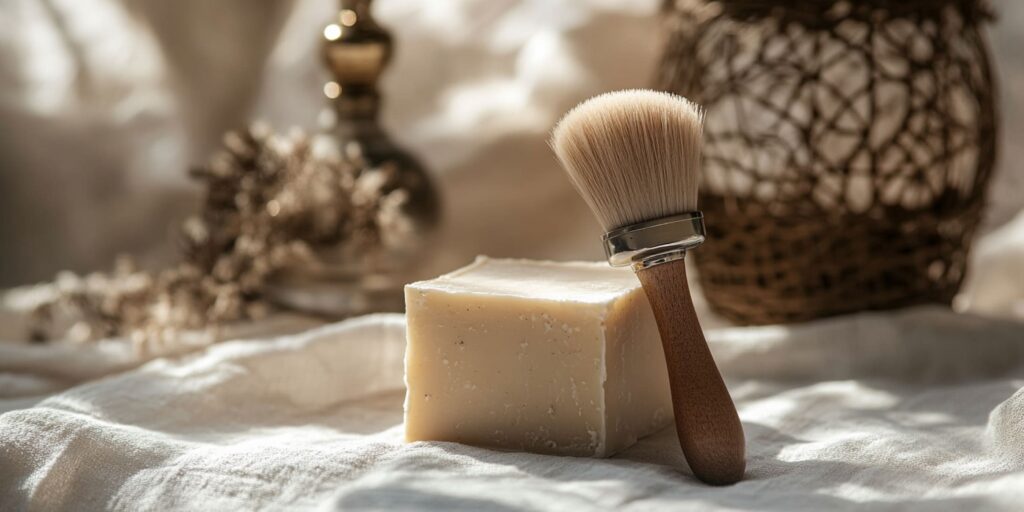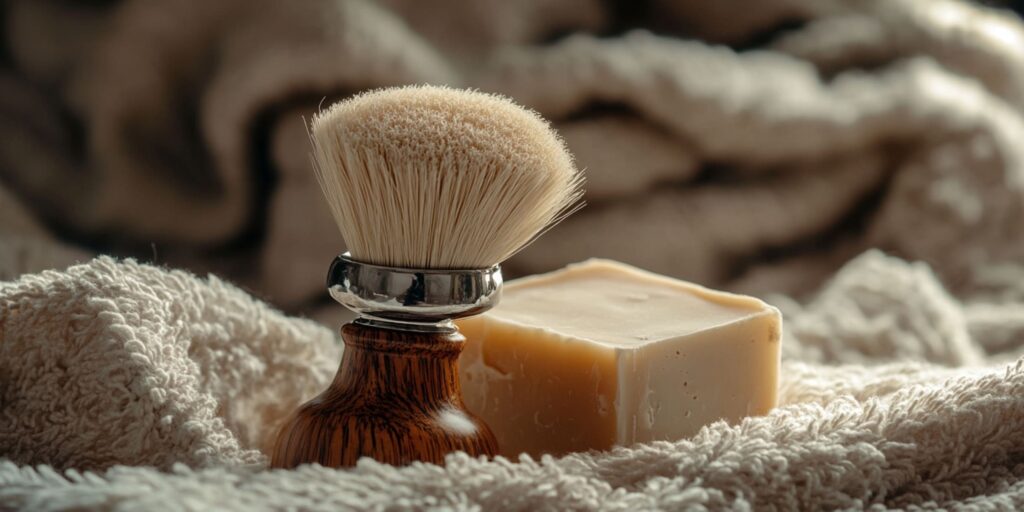Curious how to use a shaving brush? You’re in the right place!
A shaving brush isn’t just for show—it whips up rich lather, exfoliates your skin, and lifts beard hairs for a smooth, irritation-free shave.
Whether you’re new to wet shaving or looking to level up, this guide has all the tips and tricks you need.
Ready to transform your shave? Let’s dive in!
How to Prepare a Shaving Brush for Use
Got your shaving brush ready? Great! Let’s make sure you’re set for a smooth, luxurious shave.

Here’s how to prep your brush and skin, quick and easy!
Soaking the Brush
Your brush needs a little soak before the magic happens!
- Why? Softens the bristles and makes lathering a breeze.
- How? Dip the bristles in warm (not hot!) water for 1-2 minutes. Just enough to make them happy—no boiling baths needed!
Pro Tip: Badger hair brushes love a good soak. Treat them right!
Prepping the Skin
While the brush enjoys its soak, let’s get your face ready:
- Cleanse with warm water to remove dirt and oils.
- Optional: Apply some pre-shave oil for extra smoothness.
Fun fact: Prepping your skin softens your beard, making shaving a breeze—goodbye razor burn!
Now you’re all set to move forward with learning how to use a shaving brush.
Ready for that perfect shave? Let’s do this!
How to Properly Use a Shaving Brush
When learning how to use a shaving brush with shaving soap, the key is mastering the technique to get that perfect, frothy lather for a smooth shave.

Here’s how to make the most of your shaving brush and soap!
Applying Shaving Soap
Time to load up your brush with some good ol’ shaving soap. This step is simple but key to getting a rich, creamy lather.
- Step 1: Wet your shaving brush slightly, giving it a light shake to remove excess water.
- Step 2: Swirl the brush on the shaving soap using circular motions. Keep swirling for about 20-30 seconds until the bristles are nicely coated with soap.
Pro tip: Don’t rush the swirl! The longer you swirl, the better the lather. It’s like whisking batter—take your time, and you’ll get the perfect consistency.
Building the Lather
Now for the magic—turning that loaded brush into a frothy masterpiece! You can do this in a bowl or directly on your face.
- In a bowl: Swirl the brush in a bowl, using circular motions until a thick, creamy lather forms. The goal? A texture like fluffy whipped cream!
- Directly on your face: Start swirling the brush on your wet face, and watch the lather build as you go. The circular strokes help lift and soften your beard, prepping it perfectly for the razor.
Fun fact: Lathering on your face not only helps with the shave but feels like a mini facial massage. Who doesn’t love that?
Applying the Lather
Now that you’ve got a rich lather, it’s time to apply it like a pro.
- Use circular motions to spread the lather all over your beard area. Make sure to cover every spot—no hair left behind!
- After a few swirls, use gentle up-and-down strokes to even out the lather and lift the hairs for an ultra-smooth shave.
Pro tip: Enjoy this moment. The lather not only softens the beard but also creates a protective layer, helping your razor glide smoothly over your skin.
And that’s it—you’ve mastered how to use a shaving brush with shaving soap!
Now, get ready for the smoothest, most satisfying shave of your life.
Maintaining and Cleaning Your Shaving Brush
Now that you’ve mastered how to use a shaving brush, let’s talk about keeping it in tip-top shape!

Here’s how to make sure your brush always performs like a champ.
Rinsing After Use
First things first, after each shave, give that brush a proper rinse.
- Why? Leftover soap residue can stiffen the bristles and damage your brush over time. Plus, you don’t want old soap messing with tomorrow’s lather—gross!
- How? Run the bristles under warm water (again, not too hot!) while gently squeezing out any remaining soap. Keep rinsing until the water runs clear.
Drying the Brush
Once your brush is squeaky clean, it’s time to dry it properly.
- Air drying is your best friend: Shake off excess water and let the brush air dry naturally. The key is to avoid damp bristles sitting around for too long.
- Towel drying? Be gentle! If you’re in a hurry, you can lightly dab the brush with a towel, but don’t get aggressive—no need to rough it up.
- Hang it upside down: If you’ve got a brush stand (and you should!), hang your brush bristles-down. This helps water drip out and prevents moisture from gathering in the base, which can cause the dreaded mold. Ew!
Long-term Shaving Brush Tips
To keep your brush in top condition for the long haul, it’s a good idea to give it a deep clean every now and then.
- Vinegar soak: Mix a solution of one part vinegar, two parts water, and let the brush soak for about 10 minutes. This helps remove any soap scum buildup. Just make sure to rinse thoroughly afterward—no one wants a vinegar-scented shave!
- Brush cleaner: You can also use a specialized brush cleaner (they do exist!) for a deeper clean. It’s like a spa day for your brush.
And there you have it—easy ways to keep your shaving brush in top shape.
With a little TLC, your brush will stay fresh, soft, and ready to help you rock the best lather for years to come!
Now that you know how to use a shaving brush and care for it, you’re all set for the smoothest shaves of your life!
Common Mistakes to Avoid When Using a Shaving Brush
Now that you’re practically a pro at using your shaving brush, let’s make sure you’re not accidentally sabotaging your hard-earned skills.

Here’s how to avoid the most common mistakes and keep your shaving game strong.
Using Too Much Pressure
We get it—sometimes you want to really work that lather in. But pressing too hard with your shaving brush can do more harm than good.
- Why avoid it? Pressing too hard can damage those soft bristles over time, making them splay out and lose their shape. Plus, too much pressure can irritate your skin and lead to unwanted redness.
Pro tip: Light, circular motions work best to lift the hair and prep your skin for a smooth shave.
Not Rinsing Properly
We’ve all been guilty of a quick rinse and run, but leaving soap residue in your brush is a big no-no!
- Why? Soap left behind in the bristles can build up over time, leading to stiffness, a funky smell, and even bristle damage. No one wants a crusty, smelly brush!
Fun fact: A well-rinsed brush not only lasts longer but keeps each shave feeling fresh—like the first time you used it!
Storing the Brush Improperly
So, you’ve rinsed it well. Now, where do you put it? Storing your brush the wrong way can cut its life short—seriously.
- Why hang it upside down? Hanging your brush bristles-down lets water drip away from the base, preventing moisture from seeping into the handle and causing mildew or even bristle loss.
Pro tip: Invest in a brush stand! It’s a small addition that makes a huge difference.
By avoiding these common mistakes, you’ll keep your brush looking great and working like a charm.
Frequently Asked Questions
Got some questions about how to use a shaving brush?
No worries—I’ve got answers! I’ll keep it short, sweet, and fun.
Is it better to shave with a brush?
Yes! Using a brush:
- Builds a rich, thick lather
- Gently exfoliates your skin
- Lifts beard hairs for a smoother shave
In short, a brush = a better shave. Trust us, your face will notice the difference!
Do you need to soak a shaving brush?
You bet! A quick dip in warm water (not too hot!) softens the bristles and keeps them in good shape. Give it a 1-2 minute soak before each shave, and you’re good to go!
Can you shave without a shaving brush?
Technically, yes—but why would you? Without a brush, you miss out on that luxurious lather and smooth glide. Sure, you can shave without one, but where’s the fun in that?
Do you need a stand for a shaving brush?
Highly recommended! Hanging the brush bristles-down helps it dry properly and keeps it fresh. No stand? Make sure it’s drying with plenty of airflow. But seriously, a stand is a great little investment.
Do you need a bowl for a shaving brush?
Nice to have, but not essential! You can build lather in a bowl for more control, or skip it and lather right on your face. Either way, you’ll get a great shave—bowl or no bowl.
There you go! Now you’re ready to master a shaving brush like a pro!
Conclusion: Ready to Master the Art of the Shaving Brush?
You’ve made it to the end of our guide on how to use a shaving brush—and look at you now, practically a shaving brush guru!
Let’s wrap it all up and remind you of the key points, so you’re fully prepped for your next shave (and every shave after that!).
Here’s a quick recap:
- Soak your brush: Give it a 1-2 minute warm water soak before every shave to soften those bristles.
- Lather like a pro: Swirl your brush on your shaving soap, either in a bowl or directly on your face, to build that rich, creamy lather.
- Apply with care: Use circular motions to lift the hairs, then finish with smooth strokes to even out the lather.
- Don’t forget maintenance: Rinse your brush thoroughly, dry it properly, and hang it upside down to keep it fresh and fluffy.
- Avoid common mistakes: Go easy on the pressure, rinse thoroughly, and always store it properly. Easy peasy!
By following these simple steps, you’ll not only enjoy a closer, more comfortable shave, but you’ll also extend the life of your trusty shaving brush.
So, now that you’ve mastered how to use a shaving brush, it’s time to put that knowledge to work.
Grab your brush, soap, and bowl (or just your face!), and get ready for the best shave of your life.





